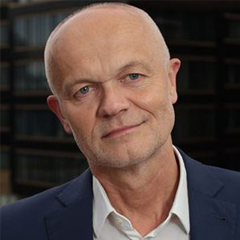
Specialization: renewable energy, solar energy technology
An engineer, economist, specialist in the renewable energy market and solar energy technology. He is the founder and president of the Institute for Renewable Energy (IEO). He is a member of the Polish Government Coordinating Council for the Development of the Photovoltaic Sector and a member of the Council of the Polish Chamber of Commerce. He is the initiator of the project to build Gigafactories of photovoltaic cells in Poland implemented by the Giga PV S.A. (2020) company and the concept of introducing zero-emission RES heat plants with seasonal heat storage into the Polish heating sector (two quotient projects 2021). Lecturer and content supervisor at postgraduate study course “Renewable energy for business” organized in collaboration with the Warsaw University of Technology.
He served as the Director of the European Commission Centre for Renewable Energy Sources (RES) and Chairman of the European Commission Reflection Group for Sustainable Energy, a member of the Energy Steering Committee at the National Centre for Research and Development (NCBiR) and the NCBiR Editorial Team for New Energy Technologies. A member of the National Council for Development advising the President of the Republic of Poland in the years 2016-2020 He was managing the work on the elaboration of government expert opinions concerning the directions of the legal regulations and economic assessment of renewable energy technologies, pivotal for the development of renewable energy. He is a co-patron of the first national “Strategy for the Development of Renewable Energy” (2001), the first draft law on renewable energy sources, assumptions for the green certificates system (2005), and an initiator of the prosumer amendment to the Act on RES (2015). In 2013, he implemented the method of counting the so-called Levelized Cost of Electricity (LCoE) as a basis for comparative economic assessment of energy technologies. Winner of the “Man of the Year of Polish Ecology 2014”.



